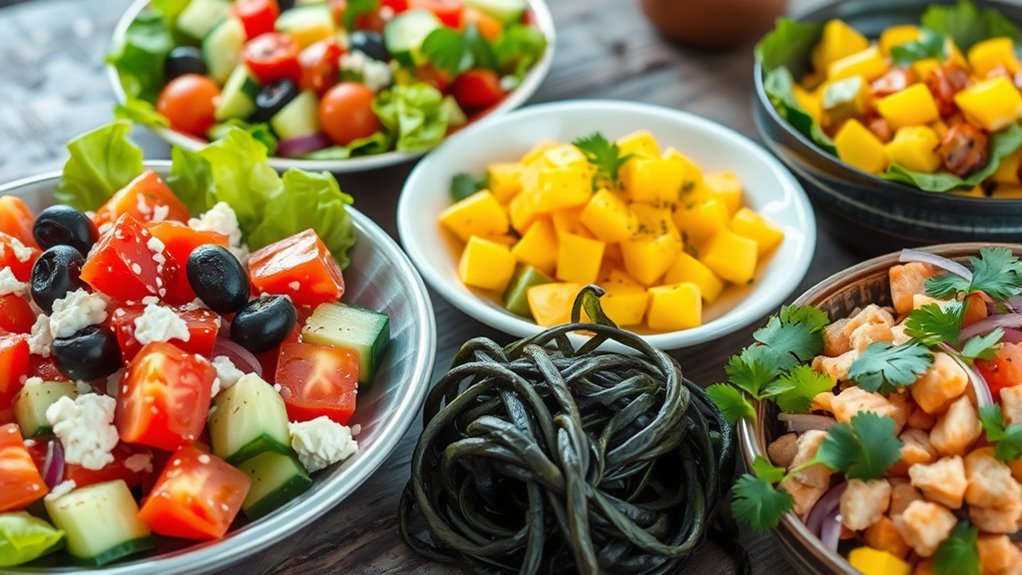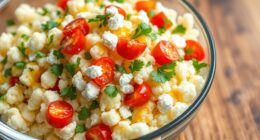Explore how salads reflect different cultures worldwide, from Mediterranean olive oil-based dishes with fresh vegetables to Japanese salads featuring seaweed and soy sauce. Latin American salads often include tropical fruits, while Middle Eastern versions highlight herbs and grains like parsley and bulgur. Southeast Asian salads are bold with unripe papaya, chili, and peanuts. Each style reveals regional tastes and ingredients—keep exploring to uncover the fascinating variety of salad traditions everywhere.
Key Takeaways
- Mediterranean salads focus on fresh vegetables, olive oil, and herbs, reflecting regional climate and agricultural abundance.
- Japanese salads incorporate seaweed, sesame, and soy sauce, emphasizing umami flavors and ocean proximity.
- Latin American salads often feature corn, beans, and tropical fruits, showcasing regional diversity and vibrant ingredients.
- Middle Eastern salads highlight herbs and grains like parsley and bulgur, emphasizing fresh, aromatic flavors.
- Southeast Asian salads combine unripe papaya, chili, lime, and peanuts for bold, spicy, and crunchy flavor profiles.

Salads are more than just a side dish—they reflect the diverse flavors, ingredients, and culinary traditions of cultures worldwide. When you explore salads from different regions, you see how local ingredients, climate, and history shape what’s on the plate.
For instance, in the Mediterranean, salads often feature fresh vegetables, olive oil, and herbs, highlighting the region’s love for simple, flavorful ingredients. Think of a Greek salad with cucumbers, tomatoes, feta, and olives—bright, tangy, and satisfying.
In contrast, Japanese salads often incorporate ingredients like seaweed, sesame, and soy sauce, creating a delicate balance of umami and freshness. A seaweed salad, for example, offers a chewy texture and a savory flavor that echoes the ocean nearby.
You’ll notice that in Latin America, salads frequently include ingredients like corn, beans, and tropical fruits, reflecting the region’s agricultural abundance. A popular Mexican salad might combine jicama, citrus, and chili for a crunchy, spicy kick.
Moving to the Middle East, salads often emphasize herbs and grains, such as tabbouleh, which mixes parsley, bulgur, tomatoes, and lemon juice. This salad’s vibrant flavors highlight the region’s love for fresh herbs and citrus.
In Southeast Asia, salads like Thai green papaya salad combine shredded unripe papaya, lime, chili, and peanuts, creating a complex mixture of spicy, sour, and crunchy textures that wake up your palate.
Different cultures also have unique ways of preparing and serving salads. In France, salads often include rich ingredients like foie gras or smoked salmon, paired with vinaigrettes that add a touch of acidity.
Meanwhile, in China, salads might incorporate pickled vegetables and sesame oil, emphasizing a balance of sour, salty, and nutty flavors. You’re likely to see salads with a focus on balance and harmony, reflecting cultural values around moderation and taste.
As you travel and taste these salads, you realize they’re more than just a way to eat vegetables—they’re an expression of identity. Each culture’s salad tells a story about its history, environment, and preferences.
By understanding the rustic decor often associated with farmhouse bedrooms, you can better appreciate how these spaces evoke a sense of timeless comfort and connection to nature. When you make or enjoy these dishes, you connect with the people and places behind them. Exploring the world’s salads invites you to appreciate how culinary traditions adapt to local ingredients and tastes, making each bite a small journey across borders and histories.
Frequently Asked Questions
What Are the Nutritional Differences Among Global Salads?
When exploring the nutritional differences among global salads, you’ll find they vary based on ingredients and preparation methods. Some salads are rich in fresh vegetables, providing vitamins and fiber, while others include proteins like fish, chicken, or beans, adding essential nutrients.
Dressings also matter; creamy ones may add calories and fats, whereas vinaigrettes offer healthier options. By choosing diverse salads, you can enjoy a balanced mix of nutrients suited to your dietary needs.
How Do Traditional Salads Reflect Local Agricultural Practices?
You’ll find that traditional salads mirror local farming practices closely. For example, in Mediterranean regions, olive oil and fresh herbs dominate, reflecting olive cultivation and herb growing.
In Asia, rice and pickled vegetables are common, highlighting local grain and preservation techniques.
About 60% of local ingredients used in traditional salads are directly sourced from nearby farms, emphasizing how regional agriculture shapes flavors and ingredients in these dishes.
Are There Specific Utensils Used for Salads in Different Cultures?
You might notice that different cultures use unique utensils for salads. For example, in some Asian countries, chopsticks are common, making it easy to pick up bite-sized pieces.
In Western settings, a fork and knife are typical, helping you cut and scoop ingredients.
In Middle Eastern cultures, flatbread or hands might be used for certain salads.
These utensil choices reflect local customs and dining traditions, shaping your salad experience.
How Do Religious Beliefs Influence Salad Ingredients Worldwide?
When you look at how religious beliefs influence salad ingredients worldwide, you see that they often shape what’s acceptable or taboo. For instance, Hindus avoid beef, so their salads skip it.
While Muslims and Jews adhere to halal and kosher rules, respectively. These beliefs act as a guiding light, ensuring that your salad choices respect spiritual practices.
It’s clear that faith can turn a simple salad into a reflection of cultural identity.
What Are the Seasonal Variations in Salad Ingredients Across Cultures?
You’ll notice that seasonal variations greatly influence salad ingredients across cultures.
In spring, you might find fresh greens, herbs, and early vegetables like radishes or peas.
Summer salads often feature tomatoes, cucumbers, and fruits such as berries or melons.
During fall and winter, root vegetables, hearty greens, and preserved items like pickles or dried fruits become common.
These seasonal choices reflect local harvests and climate, adding freshness and tradition to each salad.
Conclusion
No matter where you go, salads reflect the heart of a culture, blending local ingredients and flavors. As you explore these dishes, you realize that food truly brings people together across borders. It’s a reminder that, in the grand scheme of things, we’re all on the same page, sharing a common love for good food. So, keep an open mind and taste the world—there’s a whole salad bowl of traditions waiting for you to discover.









